Disclaimer: This story includes images of child loss and may be triggering to some.
“Everyone thinks pregnancy and babies go hand in hand. Complications like stillbirth and birth injuries aren’t mentioned because no one wants to believe that babies die. That’s right. I said it. The ‘d-word.’ Die, dead, dying, death. Words no one wants to utter but should. Because babies die. My baby died. But our story isn’t just about death. It’s a story of hope, perseverance, determination, and pure, true unconditional love.
Our experience with losing a child is different than most. I reminisce of our time with Charly with fondness and thankfulness because we were able to have her for one whole year longer than we should have. She was seconds away from being stillborn, but she was alive. She wasn’t supposed to make it home from the hospital, but she was resilient. We were given weeks or months with her, but she persevered for a year. Her life was truly a miracle so looking back on our time, I’m not bitter or callous. I feel deeply and profoundly grateful.
All my life, I wanted to be a mother. In fact, the pickup line that reeled in my husband Andy was a rather blatant observation about his perceived fertility. I had babies on the mind, all the time. But more than that, I wanted true love. Head over heels, stop your heart, fall into the rabbit hole, lose track of time kind of love. When I met Andy, I couldn’t believe God had made the perfect human for me and dropped him in my path. Though it’s been over 10 years, I still feel a sweeping giddiness if my husband winks at me in public or grabs my hand for an impromptu kitchen dance. When we got married, we set out to have a baby immediately. After three years of trying everything in the book, including quite literally standing on my head, we decided it was time to seek help. It turned out Andy had a disorder that caused him to produce sperm, but it was trapped by scar tissue like a natural vasectomy. We wasted no time with IVF. Andy went under the knife and froze sperm.
Then we pumped my already hormonal body full of more drugs than you can imagine and with time, I became pregnant with Charly. Our first embryo. Our first baby.
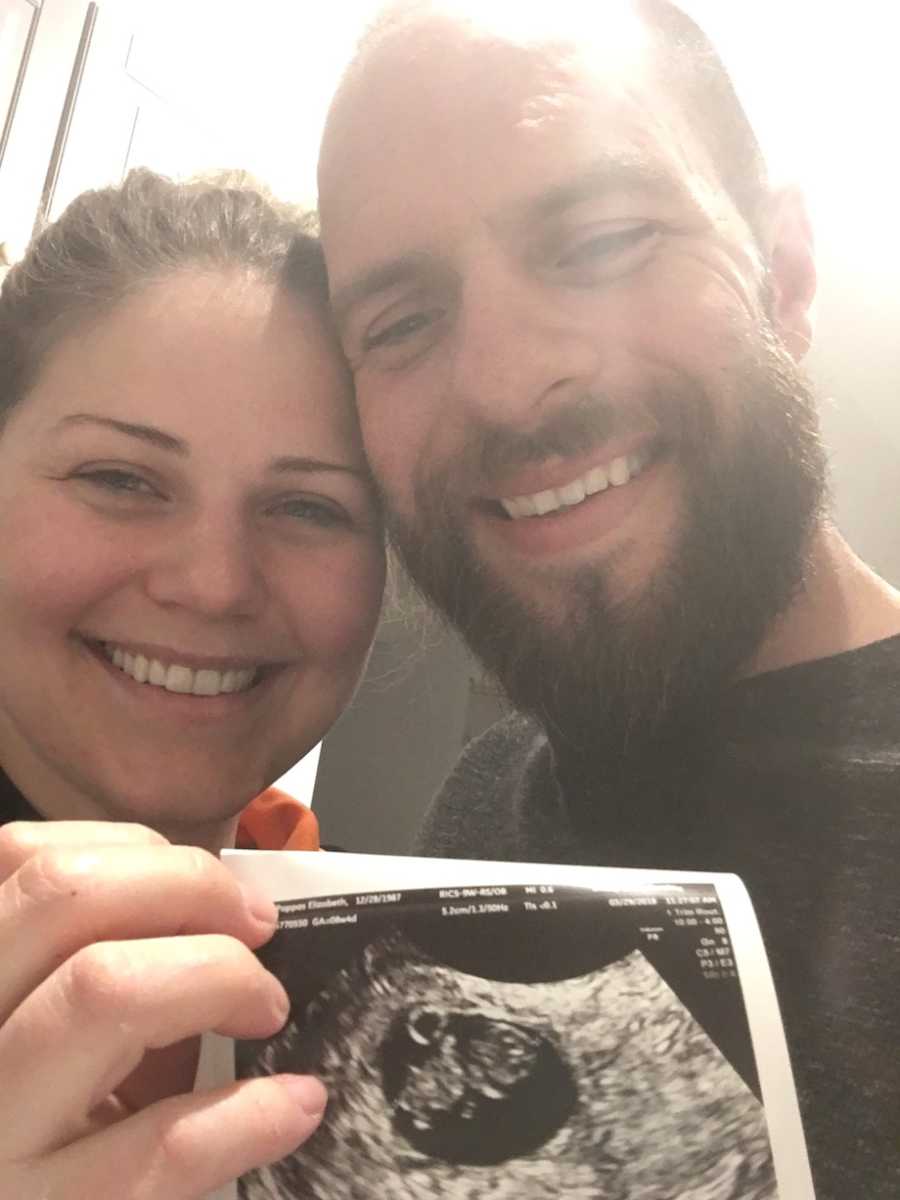
We wanted her so badly. We spent the next nine months dreaming about her future. We chose Charlotte Josephine Pappas because Charly was the only name we could agree upon. We practiced yelling ‘CJP!’ when we dreamt about cheering for her on the Varsity soccer field. I vowed to let her be whoever she wanted to be and do anything she wanted to do.
I had an absurdly smooth pregnancy. I felt amazing, like I could conquer the world. My body was growing a human. A real human baby that started as a microscopic embryo that an embryologist deemed ‘good looking’ and grew into a child that swirled about and kicked my ribs and rearranged my organs to make room for her perfect body.
The last month or so, things felt increasingly more abnormal. I remember telling Andy I finally understood what people meant when they said they were exhausted because up until then, I thought I was Superwoman. Charly stopped moving as much. Internet searches assured me babies move less in the last trimester because they have less space, so I didn’t give it much thought. I wish I could go back to that internet search and scroll a little more, add in another keyword like ‘complications’ or ‘warning signs’ so I would see I should have been concerned. But I didn’t.

The day Charly was born was the most traumatic day of our lives thus far. November 6 was the day my baby almost died. The day I found out my body had unbeknownst to me been slowly killing her for months. Every time I share her birth story, I become a little more accustomed to the trauma. I can sit in it a little bit longer, push the bruise a little harder. But now her birth is just a speck of gunpowder in a landmine of trauma. I can punch the bruise without pain because now there’s a gaping wound from watching my baby die in my arms.
Charly was born via an emergency c-section with only a faint heartbeat. She was intubated and immediately placed on the Hypothermic Cooling Protocol to try and repair the damage to her brain. In the recovery room, I stared at the clock and cried. Andy paced. As the minutes passed like seconds, we felt as if we were in an alternate reality where time was moving in fast forward, yet we were frozen. I distinctly remember wondering if this is what those cinematic time-lapse scenes would feel like. Nurses came and went, typed on computers, checked my blood pressure, adjusted my pillows. They moved at hyper speed while Andy and I were in slow motion. I distinctly remember watching the minute hand fly around the clock in awe it wasn’t the second hand. Maybe it was the drugs, maybe it was shock. We were stunned, exhausted, and terrified out of our minds.

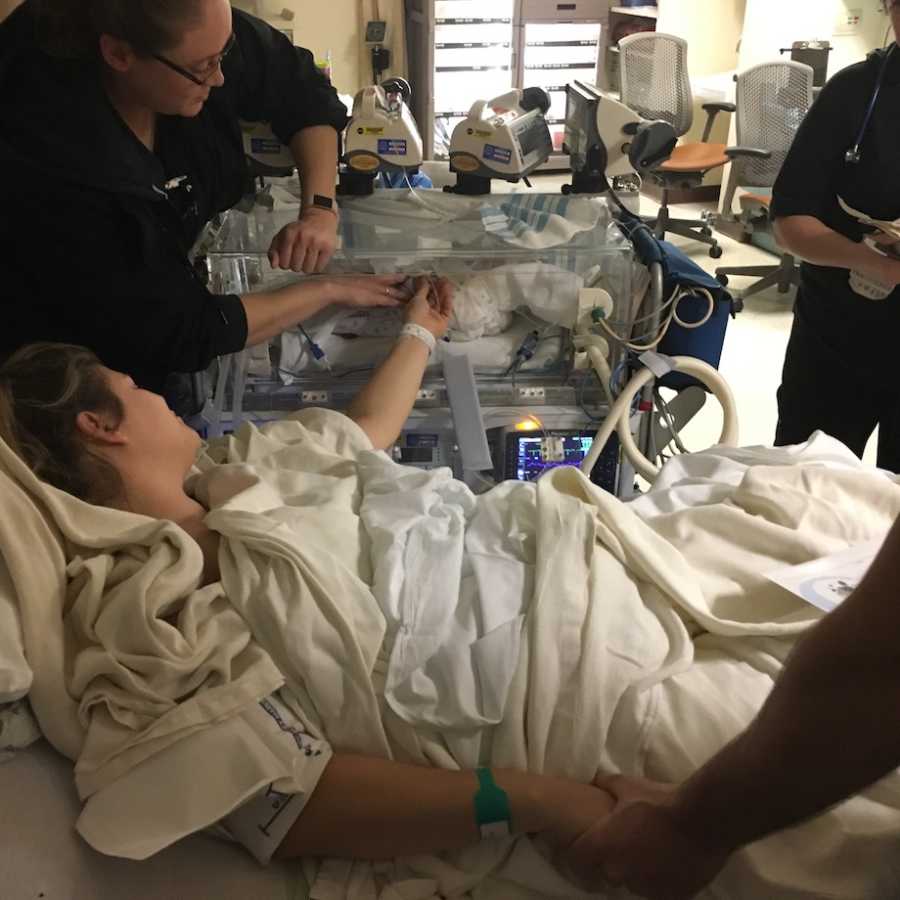
Just as my birth story wasn’t what I expected, neither was my recovery. For the first few days, I FaceTimed with Andy and Charly, then we stayed in a hotel near the NICU. I waddled my bleeding, stapled, breast milk dripping body to a shuttle that would take me to my baby. After five days, we were given Charly’s diagnosis. She had Hypoxic-Ischemic Encephalopathy (HIE), which is basically brain damage caused by lack of oxygen to the brain. As we spoke with her care team words like ‘global damage,’ ‘gray matter,’ ‘corpus callosum,’ ‘basal ganglia,’ and ‘irreversible’ swirled in the air as we choked back tears. Cerebral Palsy and tracheostomies, quadriplegia, and g-tubes. 24-hour nursing. Palliative Care. Shortened life expectancy. The neurologists were amazed she even moved based on her MRI. They compared her to a doll. Physically here, but unable to move or communicate in any way. Andy and I sat stunned and heartbroken. How could the most perfect looking baby have so much brain damage?
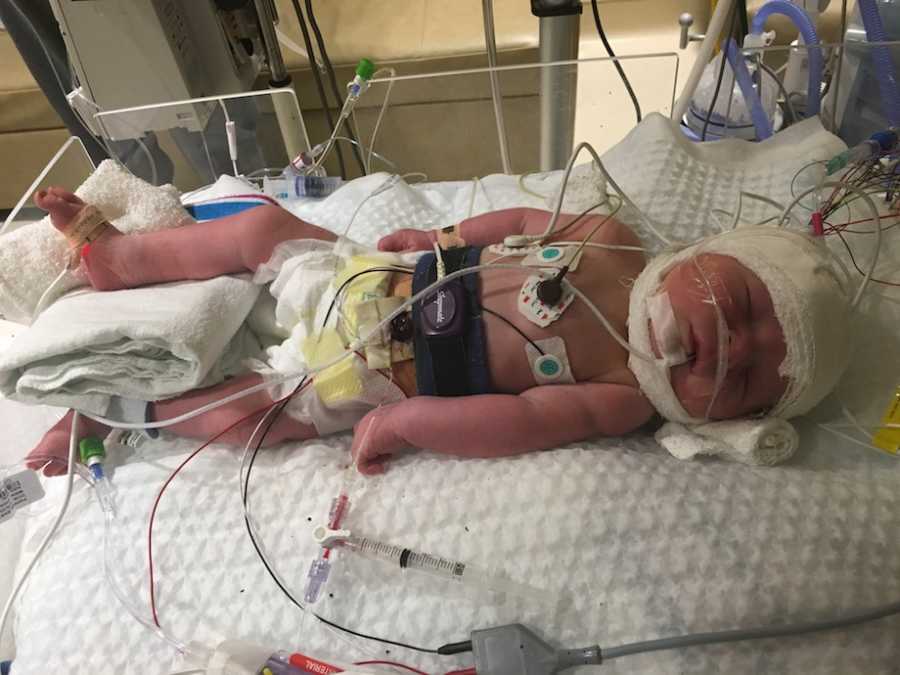
As time went on, our definition of the ‘worst-case scenario’ changed. It started as arm braces for walking and learning sign language. Then it went to using a wheelchair and needing adaptive technology to communicate. It soon landed on merely being cognizant of the world around her, even if she couldn’t interact with it. We just wanted her to breathe, to live. As the weeks went on, doctors and specialists looked sadder and sadder. They explained time after time Charly would never do more than what she’s doing at this moment. The unintentional looks of pity deepened as Andy and I researched, advocated, and pushed for answers. We got second opinions, third opinions, more tests, more bloodwork, more EEGs, more MRIs. We became overnight neurologists. We read every article we could find and peppered the doctors with questions of alternative therapies. But after a while, we just stopped. Stopped looking at Charly’s shortcomings. Stopped comparing her to neuro-typical babies. Stopped wondering what her future would look like and just focused on who she was right now in this moment. We never gave up hope. We continued to research, advocate, and push for everything Charly needed and deserved, but at some point, we simply began to enjoy Charly just the way she is. We laughed at her silly faces and savored the smell of her hair. We loved her relentlessly every day, regardless of how she scored on developmental exams. We chose to cherish every single moment we had with her, not knowing when it might be the last.

Everything looked bleaker and bleaker as our time in the NICU dragged on. Soon all our interactions with doctors and specialists included discussion of quality of life and withdrawing care. We were told if we withdrew care now, it would be easier to say goodbye because we wouldn’t be so attached to her. But that’s not how love works. When you love someone unconditionally, you take them exactly as they are regardless of how difficult life may be or how much your heart will break. You set your own wishes aside and do everything possible to make their life the best it can be. We didn’t withdraw care, but we also didn’t pursue all medical treatments available. We opted in for a g-tube but out of a trach. Every decision was made only after months of prayerful consideration. After 63 days in the NICU, our Charly Barley, as we liked to call her, finally came home.
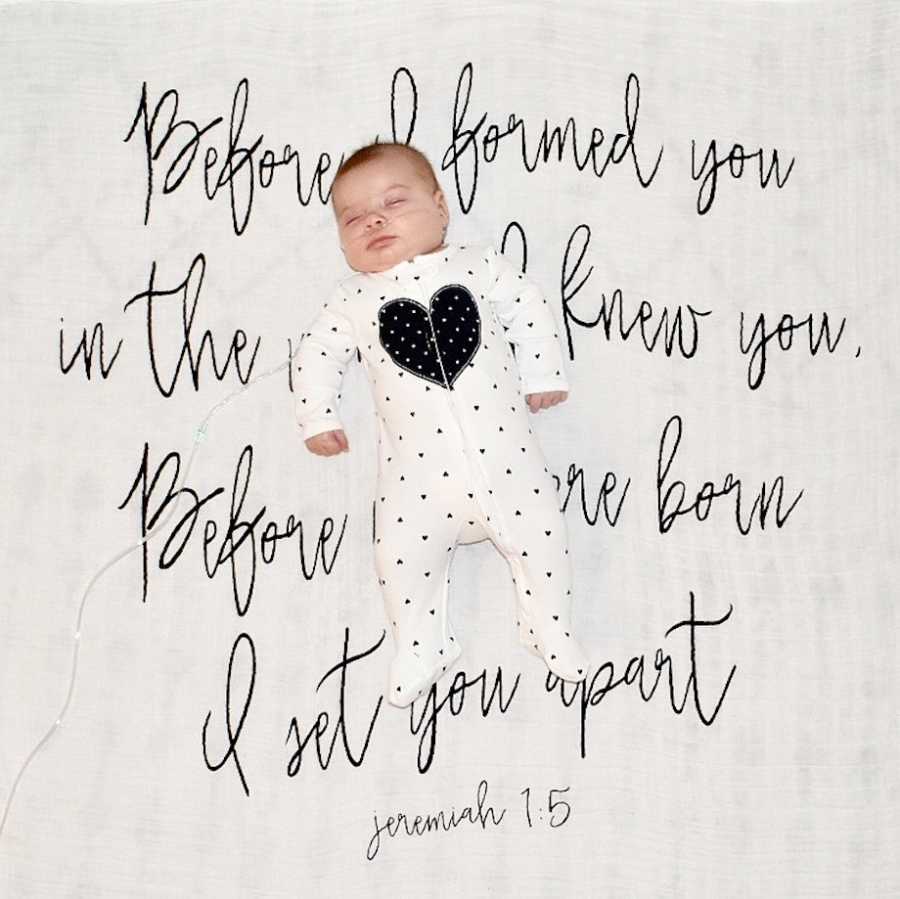
The first few months were perfection. We snuggled and sang and laughed and kissed her entire body every day. We learned to adjust her oxygen and switch out her cords, we became experts at g-tube feeding, physical therapy, occupational therapy, and vision therapy. We suctioned around the clock to keep her airways clear since she couldn’t swallow. We didn’t have nursing. It was just Andy and I in the midst of the ultimate team building challenge: keep the baby alive. We became adept to her needs as if they were our own. She didn’t cry, but we knew what every single gurgle and coo meant. Life was wonderful and terrible at the same time.
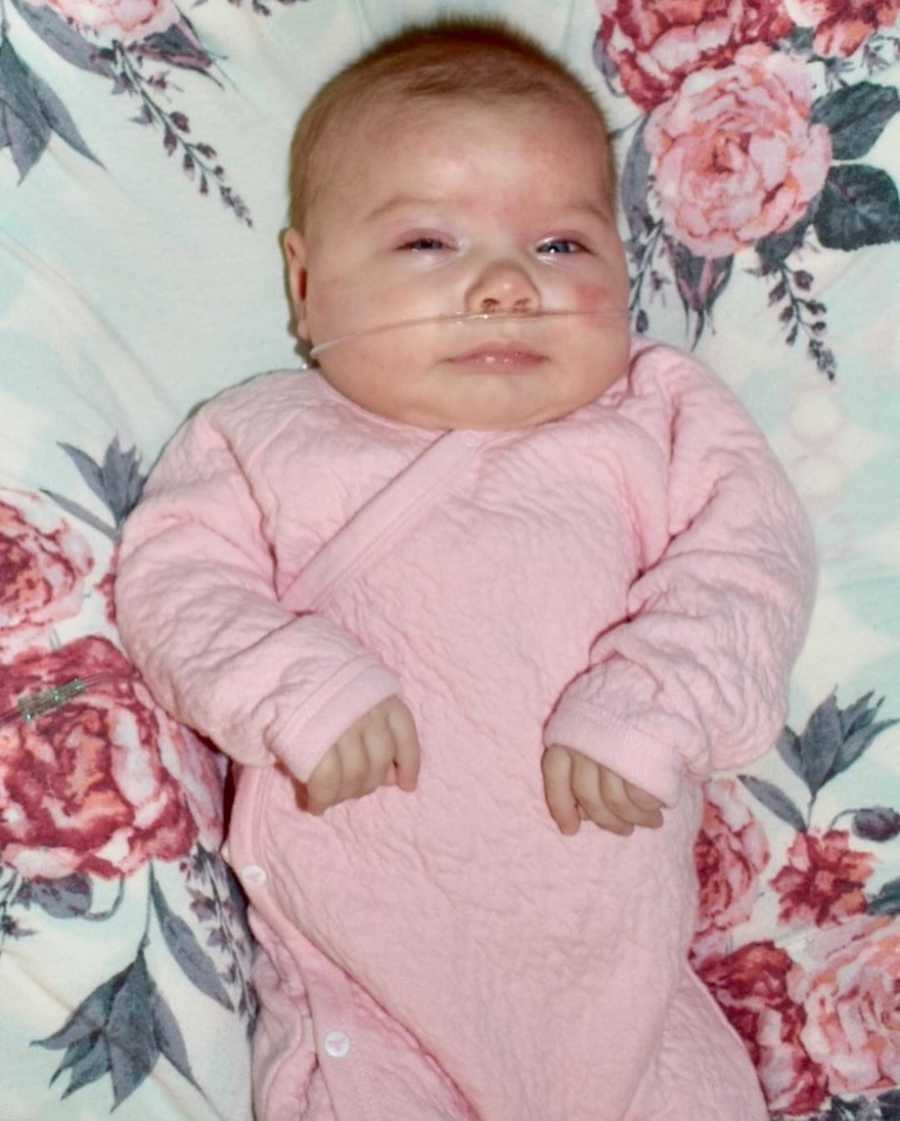
Every second mattered. We had to be on our top game 24 hours a day because if we slacked, she’d die. The next year was filled with a type of grief and depression I think can only come from caring for a terminally ill baby. It’s like skating on a lake covered in a thin layer of ice. With every lunge, you’re certain you will plunge to your death. You even see the ice cracking, but somehow it barely stays intact and you make it another day. Eventually, you become so accustomed to the sound of crumbling ice you begin to enjoy your skate regardless of the inherent danger. You’re fully aware of what’s lurking beneath you, but you decide to push the fear down so you can revel in the fleeting joy of the moment.
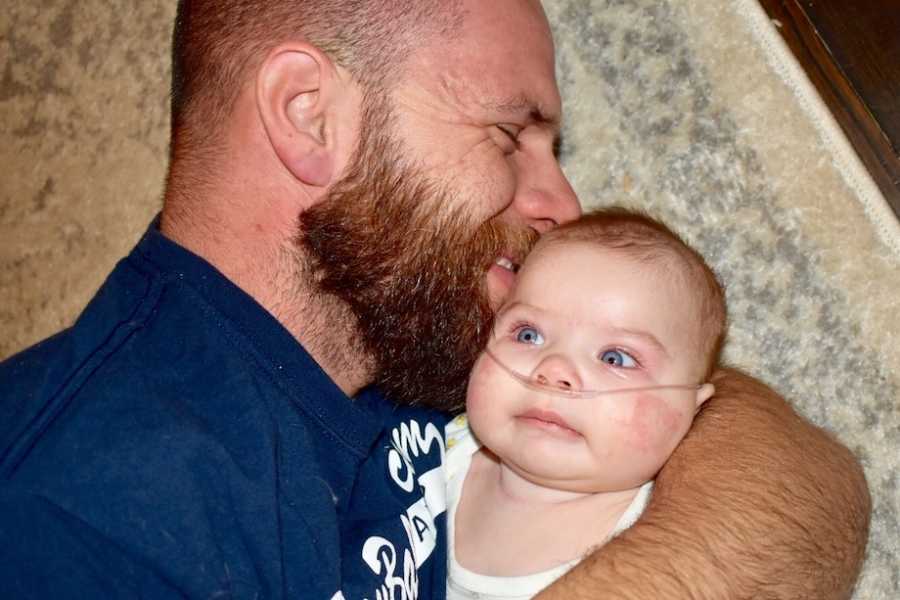
We always said we’d let Charly lead the way. If she was sick, we’d help her get better. But we couldn’t fix her brain. No one could. Charly’s brain was damaged all the way down to the core. When brain cells are dying, less vital functions are killed off first. Things like the ability to read, compute math problems, and think critically go first. Then, it’s the use of your limbs and other muscles in your body. At the very center of your brain, deep in the core, is the brain’s ability to tell your lungs to breathe deep breaths and perform oral functions such as swallowing and coughing. Charly could take tiny shallow breaths with the help of her nasal cannula. Every once in a while, we’d get a slow head turn or a leg kick and our hearts would burst with pride. She was the most peaceful Sleeping Beauty we’d ever seen. Charly taught us so much about life. She showed us one human being can impact hundreds of people. She taught us to slow down, be thankful, and to trust God. We learned everyone has a divine purpose on this earth, regardless of their abilities.
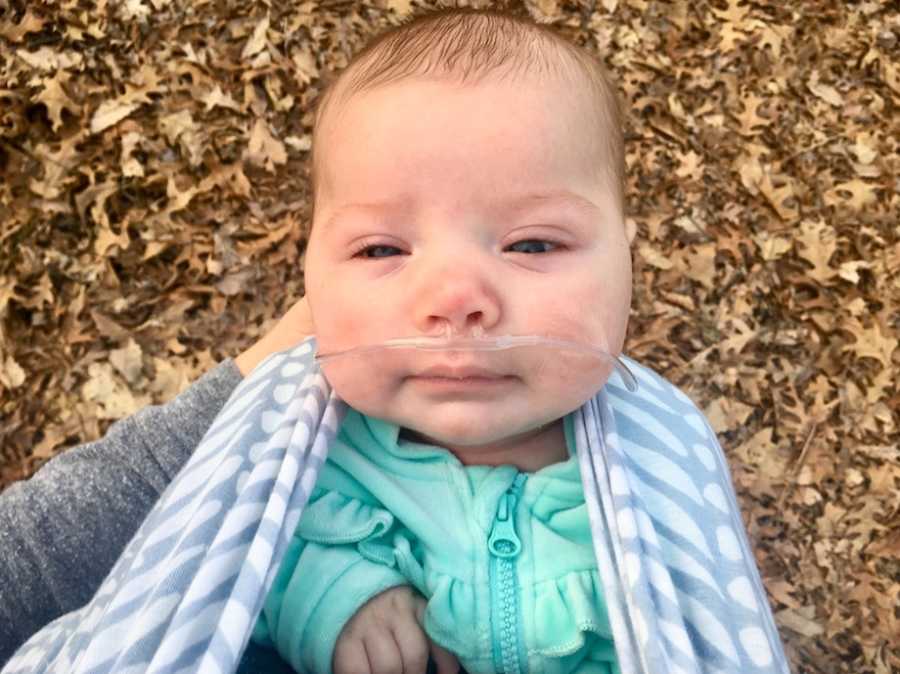
As time went on, Charly fought and overcame various illnesses and hospital stays. Each time, she couldn’t fully recover though. Her baseline dropped lower and lower with every illness. Then came the seizures. It was a constant merry go round of seizures and stress The seizures stressed her body out, then the stress caused more seizures, along with other side effects. By mid-summer, her oxygen requirement was 8 times what it was in January. Our hospice team helped us navigate drugs like Morphine and Lorazepam for her pain, on top of the slew of prescriptions to control her seizures and aid in bowel movements. As her needs increased, so did her machinery. She accumulated medical equipment like kids collect toys. Instead of stuffed animals in her nursery, she was surrounded by a multitude of breathing mechanisms.
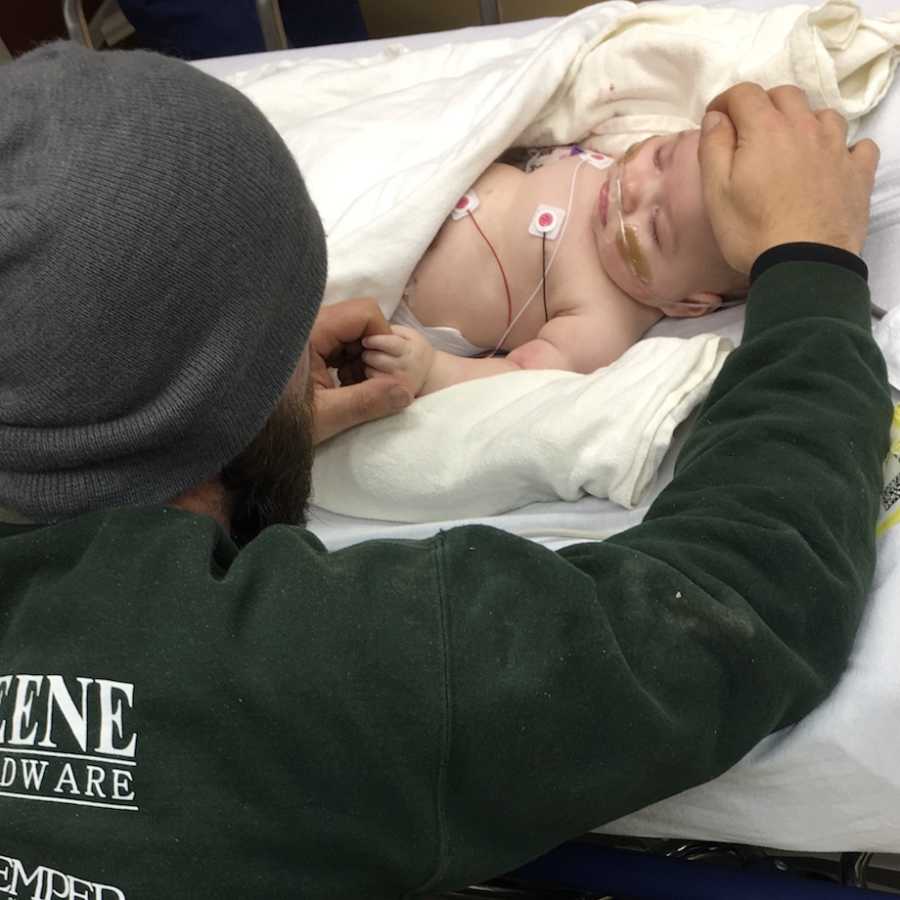
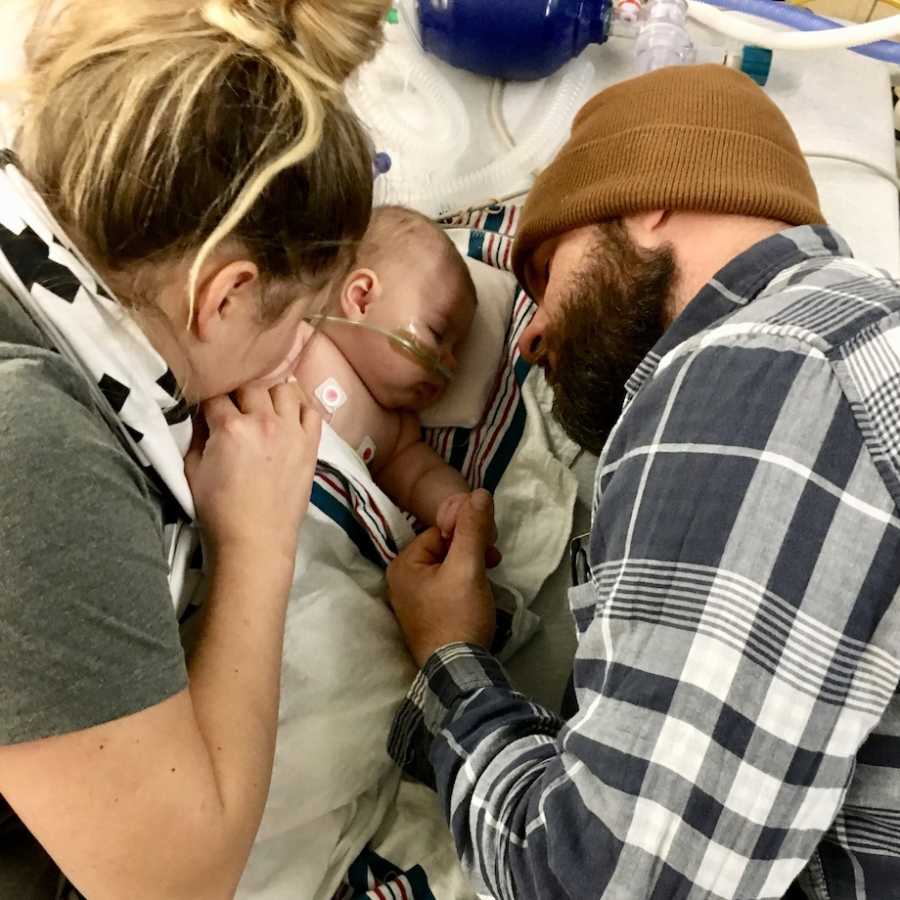
Charly’s eventual death was a fact of life. It was the looming presence in every room of our house, our constant companion as we lay awake at night wondering and worrying. We had to think about and talk about death because it wasn’t going anywhere. Ignoring it doesn’t make it any less present. Discussions of death were as common in our house as, ‘Hey, I emptied the dishwasher.’ Although sentences like ‘when Charly dies,’ were commonplace, we marveled at her resiliency and strength.


In the fall, she had her first major episode. Her oxygen dropped so far her monitor flatlined. I happened to be in a workout class at the time. The front desk got a call and interrupted the class. All I heard was ’emergency’ and I knew. I just remember throwing my weights and sprinting out of the studio. I must have looked like an inconsiderate fool, but I didn’t care. I sped to the house and scooped up her purple lipped, shivering, scorching body then dropped to the floor and set her on top of my chest. I pushed the nasal cannula into her nose and rubbed her back in circles while I breathed slow deep breaths. I don’t know why this worked. Medically, there is nothing about my reaction that should help a baby breathe. But Charly knew her mommy. She knew my chest and my voice and somehow that kept her alive.
After that, Andy quit his job and became a stay at home dad. His entire existence was solely devoted to Charly. He was tuned in to her every need and became her doctor, nurse, therapist, and more. The next two months were heartbreaking. Charly had weekly episodes like the one before. Soon she was having episodes multiple times a week, then nearly every day. ‘Episode’ is a socially acceptable way to say she almost died. The problem was she wasn’t sick. She didn’t have an infection or pneumonia. There was nothing we could do but watch her brain shut down. When brain cells are dead, they literally melt. There was nothing that could be done for her, save hooking her up to life support, and we didn’t want that for her. We didn’t want her last moments to be in a hospital poked and prodded by strangers. Her favorite place to be was in our arms, so that’s where she would stay.
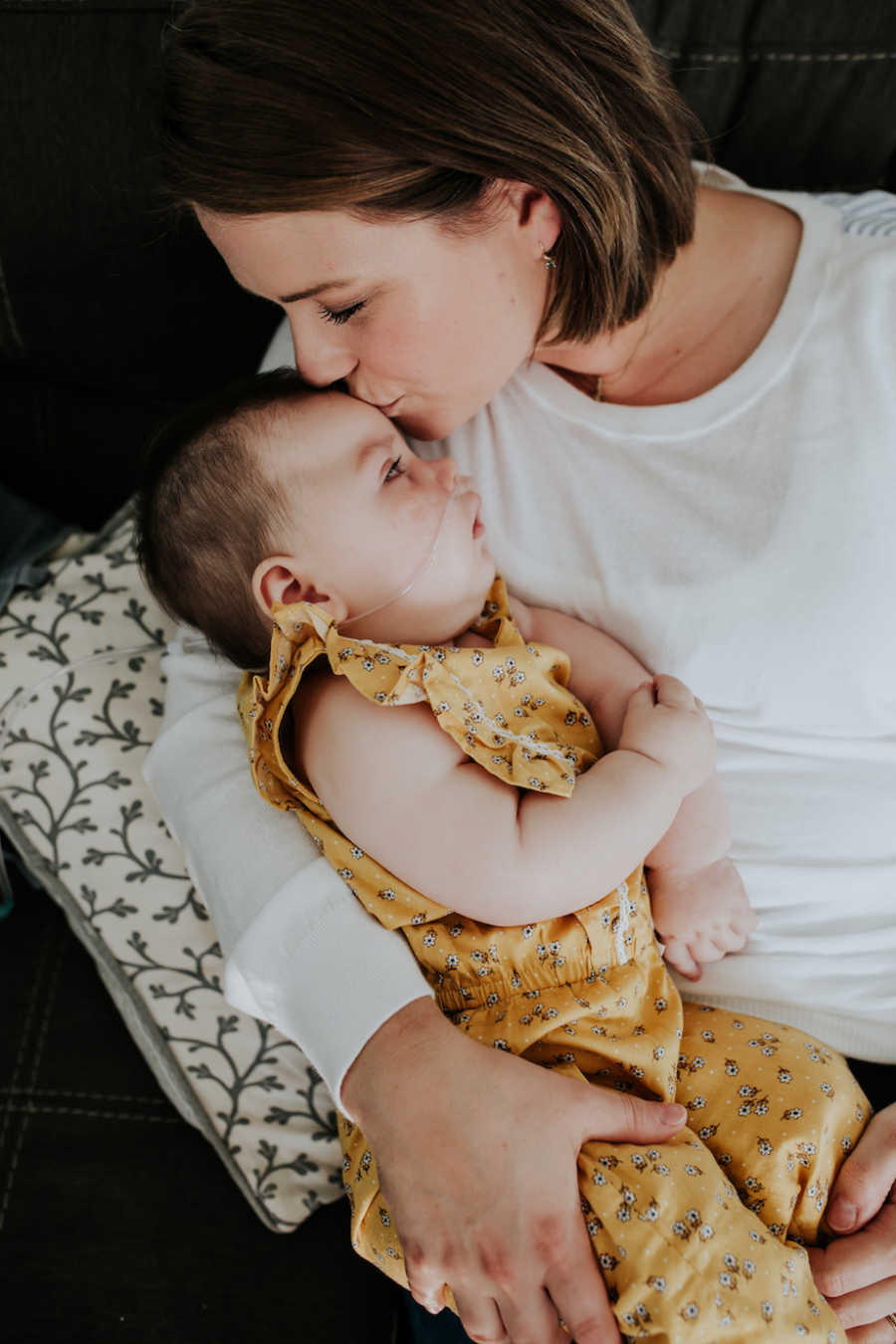
As a parent, you are always putting your child first. You want them to live as long as possible because you love them more than you can even comprehend, but you also see their pain and don’t want them to suffer. Andy and I frequently talked about our ‘lose-lose’ situation. If she died, we’d miss her but she wouldn’t feel pain anymore. If she continued living, we would get to keep her earthside just a little bit longer, but she would be in agony.
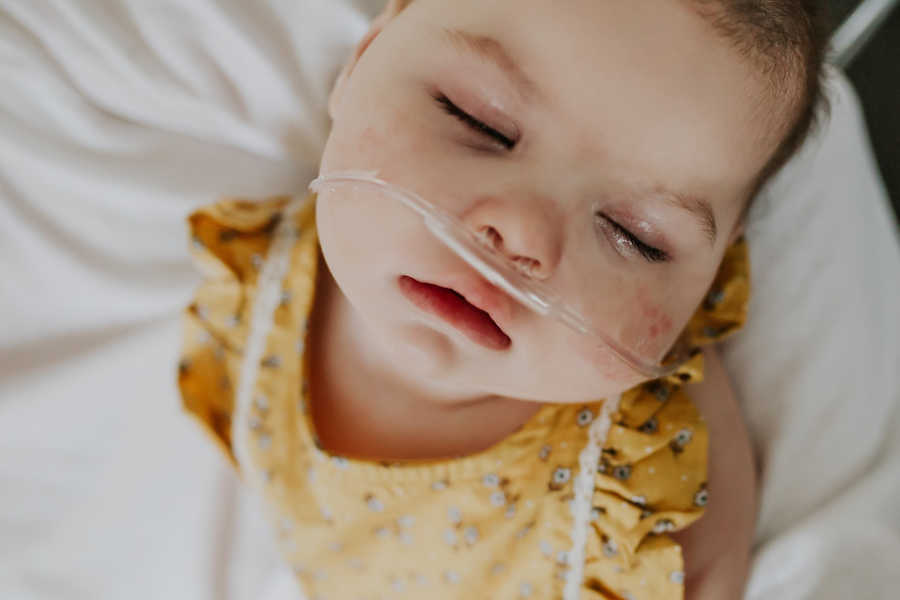
Just eleven days after Charly’s first birthday, she peacefully passed in our arms. Out of all the difficult times, the day she died is the memory that comes back to haunt me. It sneaks up when I least expect it and knocks the air out of me. I push it down because I’m not ready to unpack her last moments. If there weren’t laws against it, I would have held her lifeless body forever. I would have brought her home, tucked her into her crib, and pretended nothing happened. It was hard to believe she was actually gone because she looked exactly the same as when she was alive. The only difference was there was no slight rise and fall of her chest. When the funeral home came, I refused to put her on the gurney. I carried her to the van and only set her down at the very last second. We covered her Dock-A-tot in a white blanket, then laid her down, and wrapped her in a fuzzy fleece blanket because she was so so cold. The drive home was silent. I cried. Andy vomited.
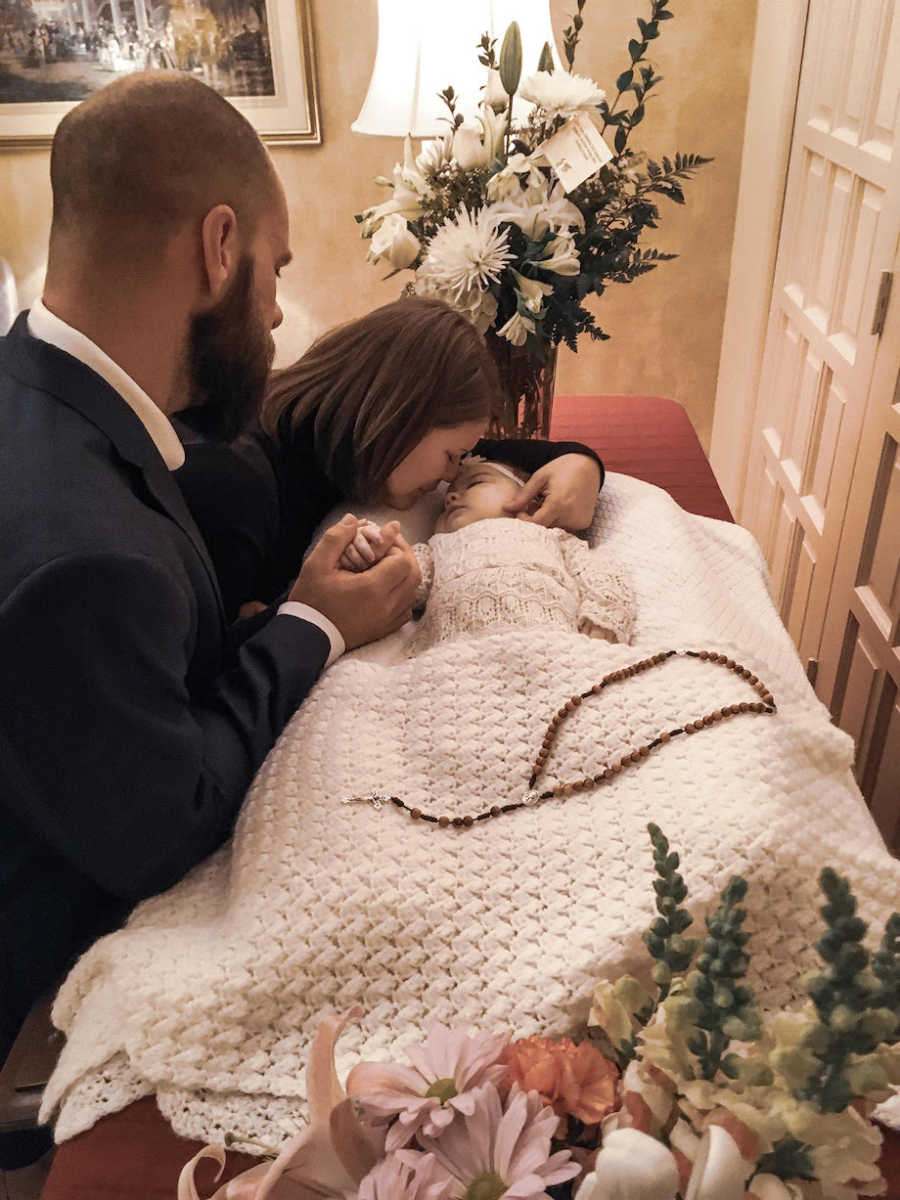
The only way I can explain losing your child is you are painfully raw. You feel like you’ve been sliced down the middle, split apart, and exposed for the world to see. You see your insides spilled out and aching, but no one else seems to realize the depth of your hurt. You’re part of a pitiful museum display; everyone passes by and stares at the intricacies of your heartbreak, but no one can get past the glass to help.
Everything hurts. You depend on Xanax to sleep and when you wake you consider taking another. Life is meaningless without your baby.
But somehow you keep going. Day by day, you and your husband hold each other up so you can make it through. Friends and family come out of the woodwork to support. Even though no one can truly take away the pain, they take care of the essential things you can’t handle. Like eating. They bring food and heat it up because they know if they don’t, it will sit in the fridge. They sit with you and remember your baby and cry with you and they’re just there and that is enough. They open your mail and organize it because the task is just too cumbersome to bear. Soon, you’re only crying a few times a day, then once a day. You start to dwell on the happy times rather than the traumatic ones, and you start smiling again.
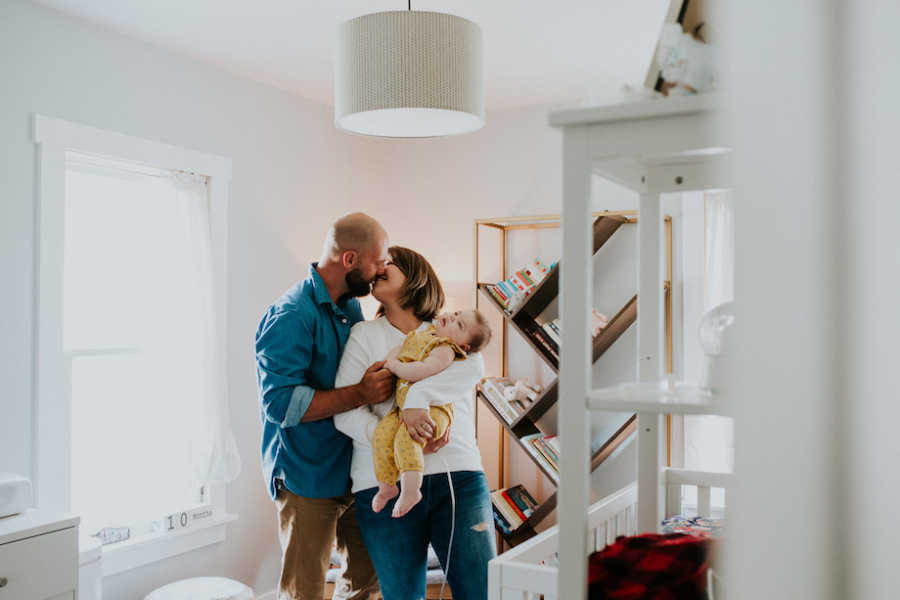
Grief is being capsized in the middle of the ocean. At first, you’re drowning in the tumultuous waters. You’re sucking in saltwater and your insides and burning and you think you’ll never make it out alive. But then your village hears your scream and comes to the rescue. They throw you a line and drag you out of the whirlpool. You barely have the energy to hang on to the rope, but you can rest briefly. Every few minutes a wave of suffocating grief splashes your face and you choke down the salt, but at least you’re not stranded anymore. Eventually, you find a raft and you realize you’ll never be able to climb up on the lifeboat with everyone else. You’re too scared to ever rejoin life before the loss, but you have your own space. Like Jack and Rose, you hold on for dear life.
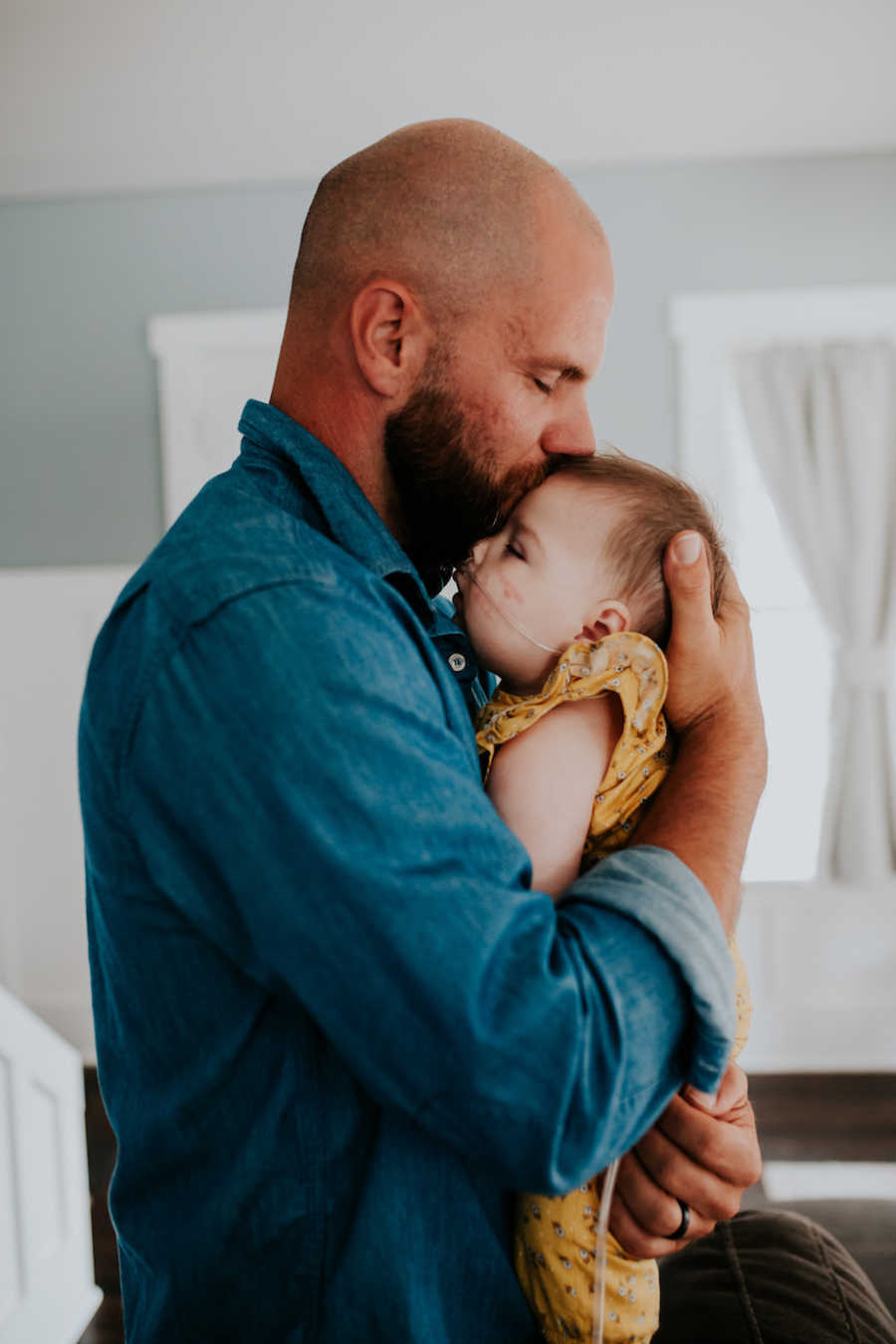
There are days when the raft capsizes and you need to find your way back from the depths. There’s even a tiny island of hope in the distance. You know happiness is out there, you can see it! And even if you make it there someday, there’s still going to be grief tsunamis striking when you least expect it. You’re hyper-aware of all the terrible things that could happen, but that’s not going to stop you from persevering. Because you truly believe life is good and memories are sweet. Nothing can take your inner joy away, and no matter what struggles are to come, you know you have your best friend by your side and your baby tugging at God’s sleeve telling Him to take care of her mommy and daddy.
The day God created Charly, He had this plan for her all along. He knew exactly who she was and He created her exactly as He wanted her to be. It’s not what we as parents expected, nor is it what the world deems as ‘normal,’ but she was created in His image. She was absolutely perfect, in His eyes and in ours.”
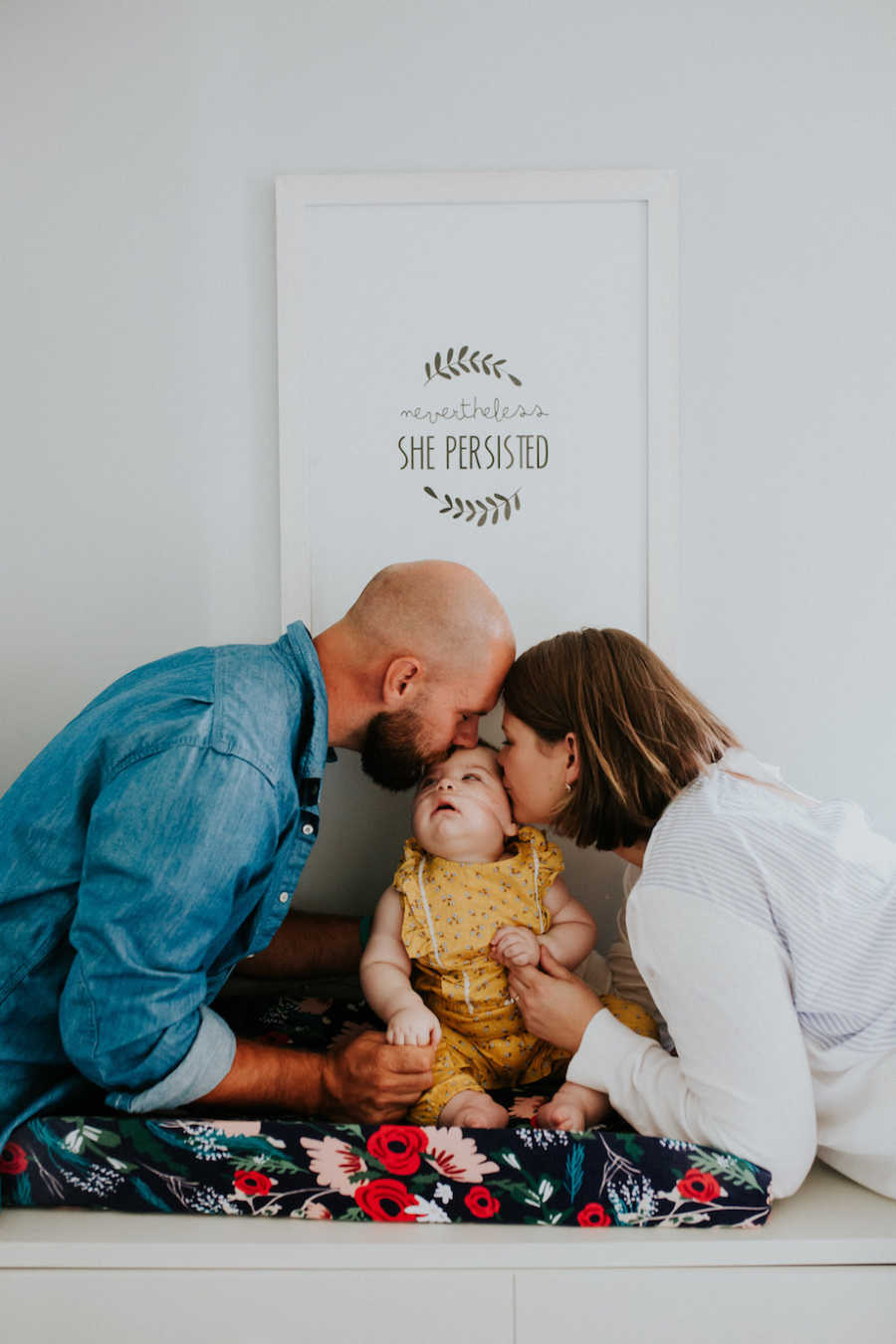
This story was submitted to Love What Matters by Liz Pappas from Baltimore, Maryland. You can follow their journey on Instagram and their website. Do you have a similar experience? We’d like to hear your important journey. Submit your own story here. Be sure to subscribe to our free email newsletter for our best stories, and YouTube for our best videos.
Read more touching stories like this:
Do you know someone who could benefit from this story? Please SHARE to let them know a community of support is available.



